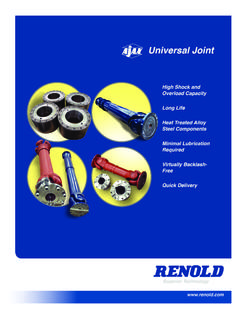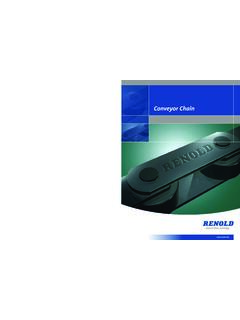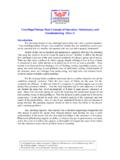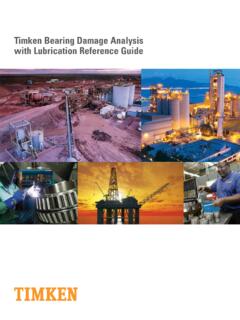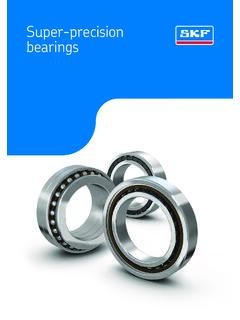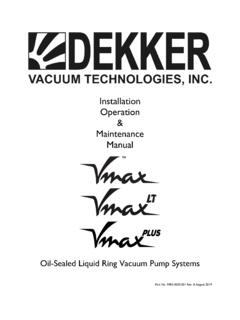Transcription of Conveyor Chain - Installation and Maintenance
1 Engineering excellence49 Conveyor Chain Installation & MAINTENANCESECTION 350engineering Chain3 IntroductionChain Installation and MaintenanceRenold Chain has, for many years, been a leader and innovatorinvolved in the design and manufacture of standard Conveyor chainand the development of engineered products for such applicationsas escalators, travelators, sterilizers, cement conveyors, leisure ridesand numerous other specialised systems for the mechanical handlingindustry. We have a detailed understanding of the maintenanceneeds on such applications and can now offer the manufacturersand operators of Conveyor systems the benefits of this is one of the most widely used moving mediums in mechanicalhandling systems, being robust and very adaptable, but it is also oneof the most neglected components within such equipment whengeneral or routine Maintenance is carried out.
2 In many cases thisproduct is attended to when problems occur, normally when thechain is already damaged and the only real option is to fit areplacement to the section has been designed with the manufacturer and operatorin mind. It covers the functional aspects of using Renold conveyorchain and emphasizes the correct use of preventative maintenanceprocedures, which will ensure better machine performance, lessdown time, lower overall Maintenance costs and extended Chain of New ChainWhen installing a complete set of new chains the method ofinstallation depends on the state of the Conveyor , if the old chainis still in place, or the Chain has been removed to allow refurbishingof the sprockets.
3 Tracks Chain Still In PlaceOn some installations where sprocket and track wear are escalators, it is possible to replace the Chain as the old Chain fixtures, slats, steps, buckets etc., which join two or more chainsshould be removed, except for enough to keep the chains at thecorrect spacing. The chains should then be broken at the tensionend by removing an outer link or connecting link as lengths of the new chains can then be attached to the oldchains using old connecting links if possible. Care should be taken toensure that the chains are in the correct orientation.
4 New fixturesshould be connected to the new Chain or old fixtures should bereconnected to maintain Chain cross drive can then be used to inch the new chains on and the oldchains the new chains have been fed onto the Conveyor the next newhandling lengths can be attached, this time using new connectinglinks. At the same time, the old Chain can be disconnected from thelower strands. Repeat until all the Chain has been Chain in PlaceWhere the Conveyor has no Chain in situ, ( after refurbishing tracksetc., or a new Conveyor ), the method of installing Chain should bedecided according to Conveyor layout, access available andequipment available.
5 The following notes are intended as a & Inclined ConveyorsWhere possible, Chain should be fed on at the take-up end of theconveyor and pulled up to the drive end. When enough Chain hasbeen installed to fill up to the drive, the Chain can then be inchedover the drive sprocket and into the return tracks. Care should betaken to make sure that the Chain is always restrained and cannot runback. NOTE: On horizontal conveyors, Chain can be fed into the returntracks either over the drive or take-up inclined conveyors the Chain will need to be hauled up using ablock and tackle, 'Tirfor' or winch (Fig.)
6 1). Care should be taken tomake sure that the Chain is always restrained and cannot run twin strand conveyors with slats/buckets etc., where access isavailable at the end of the Conveyor , the Chain handling lengths canbe fully assembled with slats/buckets etc. before being installed onthe Conveyor and then be drawn in as complete engineering excellence51 Agricultural Chain3 Chain Installation and MaintenanceBucket ElevatorsOn light duty elevators it may be possible, if access and space areavailable, to install the Chain from the top of the elevator and join thechain at the drive heavy duty elevators (usually twin strand) it may be necessary tofully or partially assemble the chains and buckets in handlinglengths and lift them up through the bottom of the casing (Fig.
7 2).When enough Chain has been assembled to reach the drivesprockets it can either be fed over the sprockets and driven down asmore Chain is installed and then joined at the bottom, or it can besecured at the top and the opposite side hauled up and joined atthe top and the : Great careshould be taken tosecure Chain properlyin elevators to prevent itfalling down inside & InstallationWhen assembling new Chain or repairing existing Chain , thefollowing precautions are ) All power to the Conveyor should be isolatedbefore any work is started on the ) Care should be taken to identify the chainand to ensure that correct replacement linksare at hand before breaking the ) The Chain tension should be slackened off completely so that joints are )
8 The sprockets should be prevented fromrotating whilst working on the Chain , especiallyon inclined conveyors or ) The Chain should be suitably restrained on bothsides of the link to be broken, or connecting linkto be ) The correct working practices should beemployed at all following points are also important and should be adhered to:-i) The necks of connecting pins should not be ground or filed to ease insertion into the Chain plates, nor should the plate holes be relieved. The press fit is an essential part of the Chain construction and should not be ) Do not apply heat to the connecting plates to ease insertion of the connecting pins.
9 This could seriously damage the material ChainThe method of Chain connection depends upon the type ofconnecting link used. The main ones are either solid pin ( , 58, 69, 86), or hollow pin (No. 107).Whichever type is used, the following steps are recommended:-Solid Pin Connectorsa) Secure the Chain on both sides of the assembly ) Unless the Chain has to run unlubricated, coat the connecting pins with grease or oil and insert the pins into the two ends of the ) Place the loose plate over the ends of the connecting pins and support the fixed plate sideof the Chain against the assembly ) Progressively force the loose plate onto the connecting pin necks equally and alternately, using a hollow punch and hammer or a hydraulic press or jack.
10 (See Fig. 3).e) When the plate is fully seated, apply the connector nut, split pin or circlip, or rivet the pin end. (See following notes on riveting).f) Check that the assembled joint flexes freely. If it is tight, a light blow on the opposite end of the connecting pins should free the Pin Connectorsa) Secure the Chain on both sides of the assembly ) Unless the Chain has to run unlubricated, coat the hollow pins with grease or oil and insert the pins into the two ends of the ) Place the loose plate over the ends of the hollow pins and support the Chain on the fixed plate side against the assembly )
